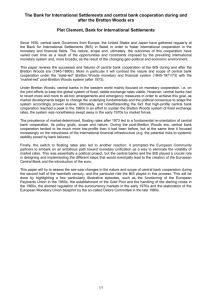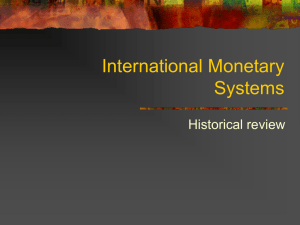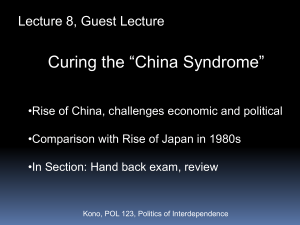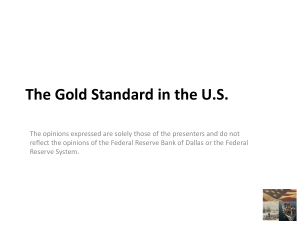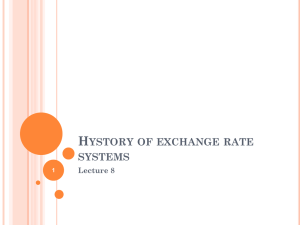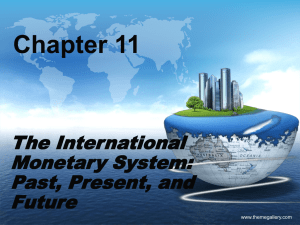(POINT OF VIEW, Roland Berger Belgium) (PDF, 363 KB)
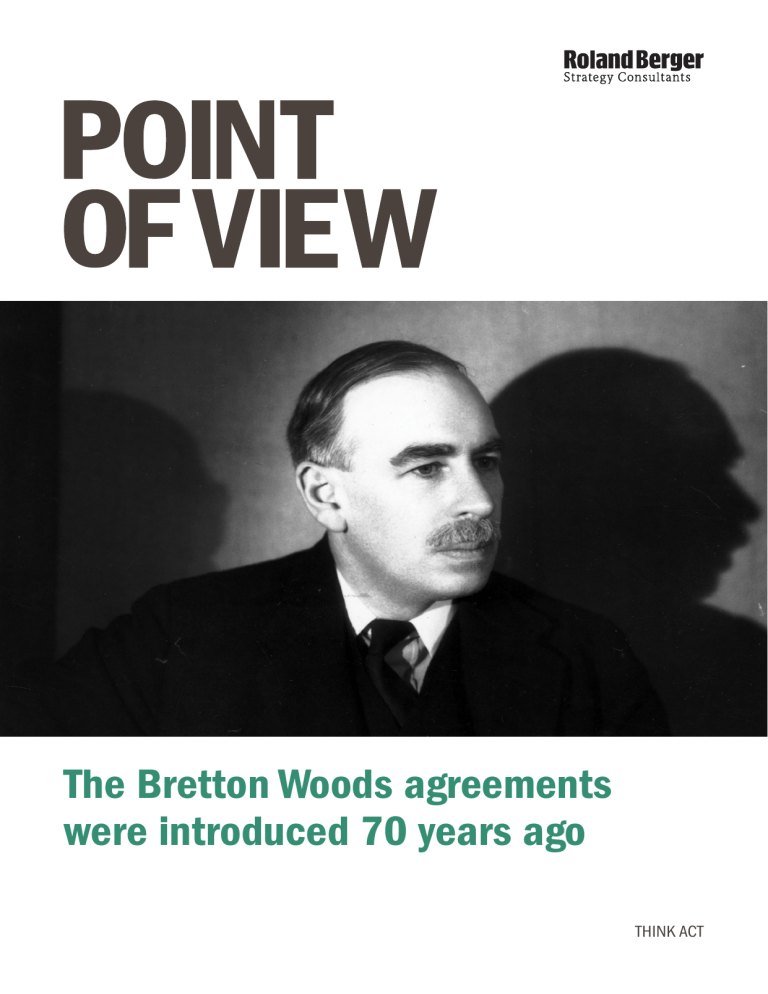
The Bretton Woods agreements were introduced 70 years ago
THINK ACT
THINK ACT – POINT OF VIEW
THE BRETTON WOODS AGREEMENTS WERE INTRODUCED 70 YEARS AGO
70 years ago, the Allied nations recast the world monetary system at the
Mount Washington Hotel in the small
New Hampshire town of Bretton Woods.
The Bretton Woods agreements were probably the greatest monetary accomplishment of the 20th century. Brought to fruition before the Allied victory over
Japan and Germany, they laid the basis for post war reconstruction and ushered in 30 years of unprecedented growth between 1944 and 1974.
2
ROLAND BERGER STRATEGY CONSULTANTS
THINK ACT – POINT OF VIEW
THE BRETTON WOODS AGREEMENTS WERE INTRODUCED 70 YEARS AGO
The Bretton Woods agreements proposed fixed exchange rates between the currencies of developed countries. Called the Gold Exchange Standard, the system determined currency rates against the dollar which in turn was tied to gold at a level of 35 dollars per ounce (31 grammes).
Under the system, the exchange rates of the various currencies were fixed, but it was agreed not to convert dollars into gold. In other words, the United States required foreign central banks holding dollars not to request their conversion into gold (which neither Germany nor France did). This arrangement led to the dollar dominating the world economy as the
United States set the pace for growth and inflation. The International Monetary Fund was founded to oversee national policies.
have been a supranational currency in an international payment system that penalised countries which exported or imported too much. Keynes wished to set up a proxy currency based on the prices of 30 commodities including gold.
The Americans themselves had initially thought of creating a currency along similar lines called the Unitas. In the end, neither the Bancor nor the Unitas saw the light of day, leaving gold at the centre of a fixed exchange rate system until the system’s collapse in 1971.
Bretton Woods also confronted the world economy with what is known as the Triffin paradox, named after the Belgian economist who formulated it. The Triffin paradox stemmed from the need for a United States balance of payments deficit to supply the world with international payment resources.
The Bretton Woods agreements saw a clash between two points of view as well as profound disagreements over monetary policy. The two protagonists were the Englishman,
Keynes, and the American, White (1892-1948), Assistant
Secretary to the United States Treasury. Keynes was outraged when White established the Gold Exchange Standard. It was doubtless introduced because the United States owned the biggest stock of gold and were aiming to align world growth with their own economic development helped notably by the
Marshall Plan in Europe. The Gold Standard was merely a secondary benchmark for ensuring the dollar’s supremacy as a reserve currency after nearly a century of dominance by the Pound Sterling. The Gold Standard was a throw-back to the 19th century when money, through gold or silver, was a store of wealth rather than a representation of it (as paper money is). The Gold Standard of the 19th century developed because of the importance of mining in the industrial revolution economy and the simultaneous occurrence of gold deposit discoveries in California, Australia, South Africa, etc. and economic growth (not the case in the 20th century).
“THE SOUND INTERNAL
ECONOMIC SYSTEM OF A
NATION IS A GREATER FACTOR
OF ITS WELL-BEING THAN
THE PRICE OF ITS CURRENCY
IN CHANGING TERMS OF
THE CURRENCIES OF OTHER
NATIONS.”
Keynes called the Gold Standard a barbaric relic and rejected benchmarks based on gold because they allowed countries with trade deficits to become dominant and to wield economic power. Opposed to Keynes and victors in the war, the United States won the day and enshrined the pivotal role of the US dollar in a fixed exchange rate system founded on dollar convertibility into gold.
The Bretton Woods agreements came to grief after 30 years due to the monetary policy of the United States. Emboldened by its role as holder of the world’s gold stocks and refusing to return these to their owner countries, the United States printed 5 to 7 times more dollars than the gold reserves were supposed to guarantee. The money printing was also linked to the cost of the Vietnam war and the space race….which in the final analysis were financed by all the countries of the dollar zone.
Keynes was therefore the loser at Bretton Woods. The British economist advocated a world monetary system based on a new international currency, the Bancor. The Bancor would
The Bretton Woods monetary agreements were scuttled on
August 15, 1971. On that day advisers from the US Treasury discreetly visited the summer residence of US President
Nixon at Camp David and took a decision which could not be undone. They simply stopped dollar convertibility into
ROLAND BERGER STRATEGY CONSULTANTS
3
THINK ACT – POINT OF VIEW
THE BRETTON WOODS AGREEMENTS WERE INTRODUCED 70 YEARS AGO gold. By the end of that disastrous summer Sunday, the US currency had returned to being a purely fiduciary currency, namely a currency based on trust and without any links to a Gold Standard that had been the foundation of monetary order for centuries.
It all became even worse: the end of the Bretton Woods agreements marked the start of a grim decade. The 70s saw two oil shocks and an unavoidable transition to a service economy at the expense of manufacturing. The terms of trade, i.e. the relative price of goods, adjusted accordingly, generating worrying rises in commodity prices.
The American decision would be the first of a fateful series of upheavals. One after another, European currencies entered a system of floating exchange rates, causing massive financial volatility. The dollar collapsed in less than a decade, thus revealing a less amiable side to the United States.
The chilling monetary rip-off was best summed up by the
Secretary to the US Treasury, John Connally (1917-1993) who said: “The dollar is our currency but your problem.”
Terrified by the break in steady economic growth, the European countries began stoking public debt which led to soaring inflation of over 10% at the start of the 1980s. At the same time, currency instability forced them to coordinate currency exchange rates leading successively to the Currency Snake and the European Monetary System which culminated in the euro.
What is more, scrutiny of United States monetary policy reveals no consistency with the possible exception of the Roosa doctrine. Roosa (1919-1993) was Kennedy’s Undersecretary of
State for the Treasury and Paul Volcker’s spiritual father. In the
1960s, Roosa asserted that a skyrocketing volume of dollars in circulation was not a US problem but one for those countries accumulating trade surpluses. The Roosa doctrine was merely an extension of the ideas of President Roosevelt who, on the eve of his first investiture, stated: “The sound internal economic system of a nation is a greater factor of its wellbeing than the price of its currency in changing terms of the currencies of other nations.”
With hindsight, it was unsustainable to link money supply to a store of gold. A monetary standard has the disadvantage of imposing excessive constraints upon on-going monetary and fiscal policies. Nonetheless, the Bretton Woods agreements had the benefit of instilling discipline among the countries. After the agreements were phased out on the initiative of the United States, Europe’s states embarked on a reckless policy of debt financing to conceal, behind deteriorating public finances, the economic transformations taking place in the 70s and 80s. Keynes was, by the way, the best alibi for anaesthetising social policies based on redistribution. We have still not paid off those debts.
The authors welcome your questions, comments and suggestions
BRUNO COLMANT, PH.D., CFA
Member of the Royal Academy of Belgium
Partner bruno.colmant@rolandberger.com
(representing Bruno Colmant Academic sprl)
ROLAND BERGER STRATEGY CONSULTANTS NV SA
Boulevard du Souverain/Vorstlaan 100
1170 Brussels, Belgium
Tel. +32 2 661 03 00 | Fax +32 2 661 03 11 www.rolandberger.be
The opinion expressed in this article are those of the authors. They will not be liable or responsible for any claims or liabilities related to the use of this information.
4
